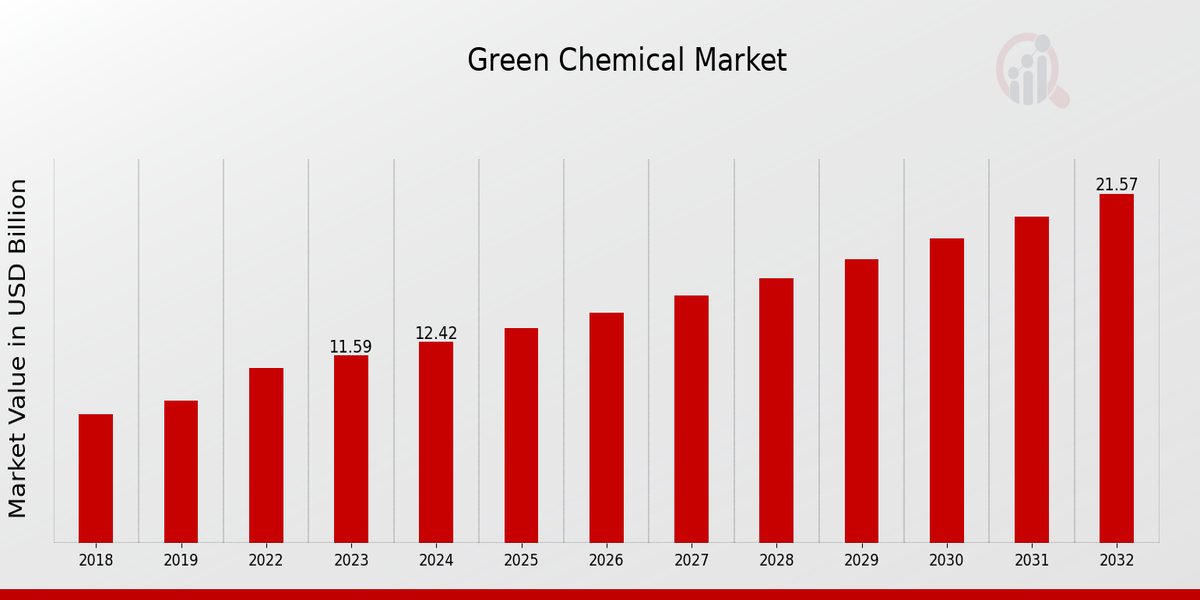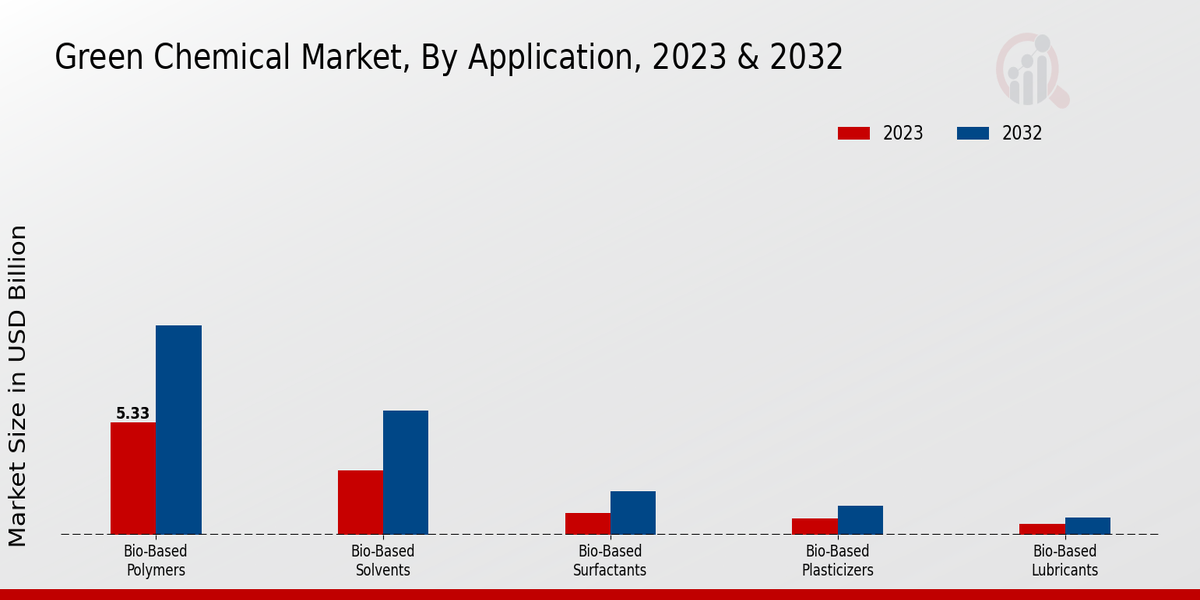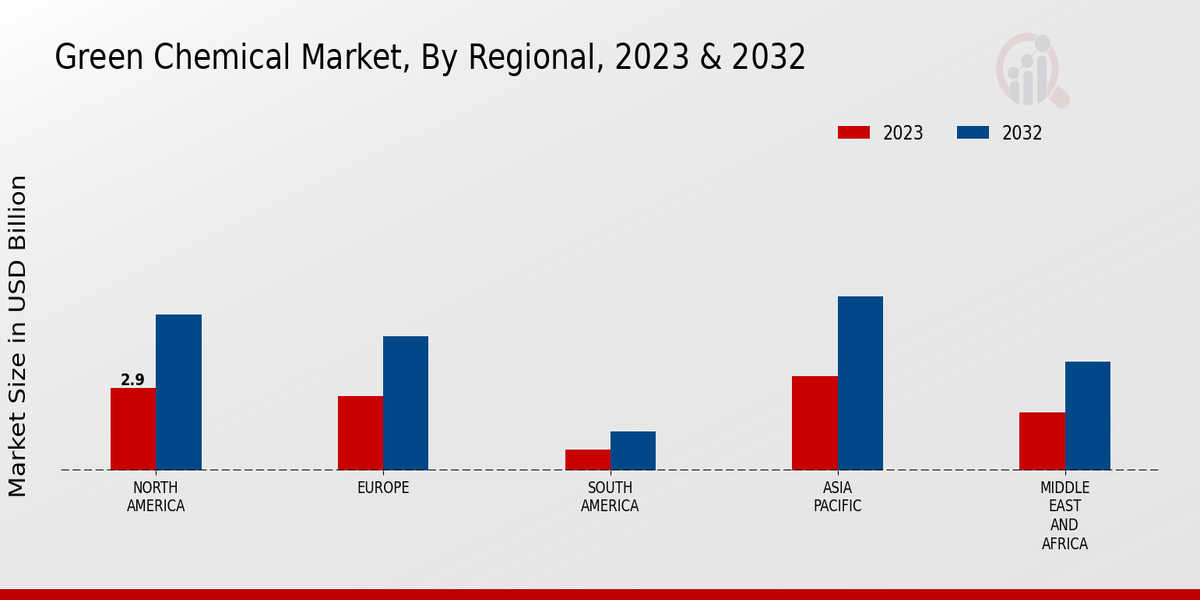Global Green Chemical Market Overview
The Green Chemical Market Size was estimated at 13.30 (USD Billion) in 2024. The Green Chemical Industry is expected to grow from 14.25 (USD Billion) in 2025 to 26.54 (USD Billion) by 2034. The Green Chemical Market CAGR (growth rate) is expected to be around 7.15% during the forecast period (2025-2034).
Key Green Chemical Market Trends Highlighted
Key market drivers include increasing environmental regulations, growing consumer demand for sustainable products, and technological advancements.
Opportunities exist in developing bio-based green chemicals, exploring innovative applications in various industries, and expanding into emerging markets.
Trends in recent times include the adoption of green chemistry principles by major chemical companies, government initiatives supporting the transition to sustainable practices, and the rise of green certifications and eco-labels.
These factors are shaping the growth trajectory of the green chemical market, presenting opportunities for market players to innovate and capture market share.

Source: Primary Research, Secondary Research, MRFR Database and Analyst Review
Green Chemical Market Drivers
Increased Demand for Sustainable Products
Consumers are becoming increasingly aware of the environmental impact of the products they use and are demanding more sustainable options. This is driving demand for green chemicals, which are produced using environmentally friendly processes and materials.
The automotive industry, construction sector, personal care industry, and many other end-use industries are increasingly looking for sustainable options to reduce their environmental impact and meet the evolving needs of their customers.
Green chemicals offer a solution to these industries, providing a way to meet these demands while also reducing their environmental footprint.
Government Regulations and Incentives
The process of reducing the environmental impact of industrial activities through regulations at the national and international levels is favoring the growth of the green chemical industry.
Many companies are required to turn to more sustainable chemicals, as local and federal governments are offering them advantageous conditions to make investments in the green chemical manufacturing process.
For example, they offer tax breaks and grants to companies that can benefit from adopting green technology, which includes green chemical ones.
Technological Advancements
Technological advancements are transforming green chemicals from being costly and uncompetitive to being produced more efficiently and cost-effectively. The production of green chemicals is increasingly becoming possible using novel catalysts and processes based on renewable resources.
With these changes, the cost of green chemicals is declining, and they are becoming more competitive compared to traditional ones. The growth of the Green Chemical Industry is expected to benefit from the technological advances projected to emerge.
Green Chemical Market Segment Insights:
Green Chemical Market Application Insights
The application segment of the green chemical market is expected to witness significant growth in the coming years, driven by increasing demand for sustainable and eco-friendly products across various industries.
Bio-based polymers, a major application segment, are gaining traction due to their biodegradable and renewable nature. The market for bio-based polymers is projected to reach $22.5 billion by 2025, growing at a CAGR of 12.3%.
Bio-based solvents, another key application segment, are witnessing increasing adoption in industries such as paints and coatings, pharmaceuticals, and cosmetics, owing to their low toxicity and reduced environmental impact.
The bio-based solvents market is anticipated to expand at a CAGR of 8.5% during the forecast period, reaching a value of $6.7 billion by 2028.
Bio-based surfactants, used in detergents, cleaning products, and personal care items, are also experiencing growing demand, driven by consumer preference for natural and sustainable products.
The market for bio-based surfactants is expected to grow at a CAGR of 9.2% from 2023 to 2030, reaching a value of $4.5 billion. Bio-based plasticizers, which enhance the flexibility and durability of plastics, are witnessing increasing adoption in the packaging industry.
The bio-based plasticizers market is projected to grow at a CAGR of 7.8% during the forecast period, reaching a value of $2.2 billion by 2026.
Bio-based lubricants, derived from renewable sources such as vegetable oils and animal fats, are gaining traction due to their superior performance and environmental benefits.
The bio-based lubricants market is expected to expand at a CAGR of 6.5% from 2023 to 2030, reaching a value of $1.8 billion. Bio-based fuel additives, used to improve fuel efficiency and reduce emissions, are also experiencing growing demand.
The bio-based fuel additives market is anticipated to grow at a CAGR of 5.2% during the forecast period, reaching a value of $1.2 billion by 2027.
Bio-based pharmaceuticals, derived from natural sources such as plants and microorganisms, are gaining attention due to their potential to treat various diseases with fewer side effects.
The bio-based pharmaceuticals market is expected to grow at a CAGR of 8.4% from 2023 to 2030, reaching a value of $1.1 billion.
Bio-based agrochemicals, used to protect crops and improve soil health, are witnessing increasing adoption due to growing concerns about the environmental impact of conventional agrochemicals.
The bio-based agrochemicals market is projected to grow at a CAGR of 7.2% during the forecast period, reaching a value of $980 million by 2026.

Source: Primary Research, Secondary Research, MRFR Database and Analyst Review
Green Chemical Market Product Type Insights
The Green Chemical Market segmentation by product type into Renewable Feedstocks, Bio-Based Chemicals, Non-Biodegradable Products, and Biodegradable Products provides in-depth insights into the industry's dynamics.
Renewable feedstocks accounted for a significant market share in 2023, owing to the rising demand for sustainable and eco-friendly raw materials.
The Bio-Based Chemicals segment is projected to witness substantial growth, driven by increasing applications in industries such as pharmaceuticals, cosmetics, and food beverages.
Non-biodegradable products, including plastics and polymers, hold a sizeable market share due to their widespread use in various end-use industries.
Biodegradable Products, such as bioplastics and biocomposites, are gaining traction as consumers become more environmentally conscious.
The Green Chemical Market revenue is anticipated to reach 12.09 billion USD in 2024, expanding at a CAGR of 7.35% during the forecast period.
Green Chemical Market Technology Insights
The technology segment of the Green Chemical Market is classified into biomass conversion, catalysis, electrochemistry, and fermentation.
Biomass conversion involves converting biomass into chemicals and fuels and is expected to account for a significant share of the market due to growing demand for renewable energy sources.
Catalysis involves using catalysts to facilitate chemical reactions and is expected to witness substantial growth due to its ability to improve efficiency and reduce waste.
Electrochemistry involves using electrical energy to drive chemical reactions and is gaining traction due to its potential for producing green hydrogen and other renewable fuels.
Fermentation involves using microorganisms to convert biomass into chemicals and is expected to grow due to its ability to produce bio-based chemicals and materials.
Green Chemical Market Regional Insights
The Green Chemical Market is expected to exhibit significant growth in the coming years, driven by increasing demand for sustainable and eco-friendly products.
Among the key regions, North America held the largest market share in 2023 and is projected to maintain its dominance throughout the forecast period.
The growth in this region can be attributed to the presence of stringent environmental regulations and a growing consumer base that is conscious of the environmental impact of chemical products.
Europe is another major market for green chemicals, with a significant contribution to the Green Chemical Market revenue.
The region has a strong focus on sustainability and is home to several leading green chemical manufacturers.
The Asia-Pacific region is expected to witness the fastest growth in the coming years, driven by rapid industrialization and increasing demand for green chemicals in various industries such as textiles, automotive, and electronics.
South America and the Middle East and Africa (MEA) are also expected to contribute to the growth of the Green Chemical Market, albeit at a slower pace compared to other regions.
Overall, the Green Chemical Market is expected to continue to grow in the coming years, driven by increasing demand for sustainable and eco-friendly products, stringent environmental regulations, and rising consumer awareness about the importance of green chemistry.

Source: Primary Research, Secondary Research, MRFR Database and Analyst Review
Green Chemical Market Key Players and Competitive Insights:
Major players in the Green Chemical Market are creating new production capacities and expanding their product portfolios.
For example, BASF has launched new innovative products, such as biomass-based solvents and biodegradable plastics, to meet the growing demand for environmentally sustainable solutions. The leading Green Chemical Market players are also investing in the development of new and improved green chemical technologies through research and development activities.
This trend is expected to intensify over the next decades, making the competitive landscape more dynamic. BASF is one of the leading companies in the Green Chemical Market, which is committed to developing innovative and sustainable solutions for customers.
It also has a strong R focus and has invested heavily in developing new and improved green chemical technologies. BASF's product portfolio includes a wide range of green chemicals, such as biomass-based solvents, lightweight, biodegradable plastics and renewable energy chemicals.
BASF is headquartered in Ludwigshafen, Germany, and operates worldwide to provide its products to customers in a wide range of industries, such as automotive, construction and electronics.
Dow, one of the main competitors in the Green Chemical Market, is also providing sustainable solutions to its customers through the development of green chemicals. Located in Midland, MI, US, the company has made a major contribution to the development of green chemical technologies.
Dow’s product portfolio includes a wide range of green chemicals, such as bio-based polymers, renewable energy chemicals and performance materials. The company is present internationally and serves customers in various industries, such as packaging, automotive and construction.
Key Companies in the Green Chemical Market Include:
Green Chemical Market Developments
The market growth is attributed to rising concerns over environmental pollution, stringent government regulations, and increasing demand for sustainable products.
Key industry developments include BASF's investment in a new production plant for bio-based intermediates, Solvay's launch of a range of bio-based solvents, and Dow's collaboration with LanzaTech to develop sustainable chemicals from carbon monoxide.
Green Chemical Market Segmentation Insights
Green Chemical Market Application Outlook
Green Chemical Market Product Type Outlook
Green Chemical Market Technology Outlook
-
Biomass Conversion
-
Catalysis
-
Electrochemistry
-
Fermentation
Green Chemical Market Regional Outlook
-
North America
-
Europe
-
South America
-
Asia Pacific
-
Middle East and Africa
| Report Attribute/Metric |
Details |
| Market Size 2024 |
13.30 (USD Billion) |
| Market Size 2025 |
14.25 (USD Billion) |
| Market Size 2034 |
26.54 (USD Billion) |
| Compound Annual Growth Rate (CAGR) |
7.15% (2025 - 2034) |
| Report Coverage |
Revenue Forecast, Competitive Landscape, Growth Factors, and Trends |
| Base Year |
2024 |
| Market Forecast Period |
2025 - 2034 |
| Historical Data |
2020 - 2024 |
| Market Forecast Units |
USD Billion |
| Key Companies Profiled |
Lanxess, Solvay, Eastman Chemical Company, Mitsui Chemicals, Inc., LG Chem, BASF, Mitsubishi Chemical Holdings Corporation, Evonik Industries, SABIC, Bayer, DuPont, Sumitomo Chemical Company, Toray Industries, The Dow Chemical Company |
| Segments Covered |
Application, Product Type, Technology, Regional |
| Key Market Opportunities |
Growing demand for sustainable products Emerging green building construction Increasing adoption in healthcare and pharmaceuticals Government regulations favoring green chemicals Rising consumer awareness of environmental impact |
| Key Market Dynamics |
Rising demand for sustainable products Technological advancements Government regulations Increasing awareness about environmental impact Growth of the biobased economy |
| Countries Covered |
North America, Europe, APAC, South America, MEA |
Frequently Asked Questions (FAQ) :
The Green Chemical Market is expected to reach USD 26.54 billion by 2034, exhibiting a CAGR of 7.15% during the forecast period (2025-2034).
The Asia-Pacific region is anticipated to dominate the Green Chemical Market, accounting for a significant market share. Additionally, North America and Europe are expected to showcase substantial growth due to stringent environmental regulations and rising consumer awareness.
Green chemicals are primarily used in various applications, including adhesives and sealants, paints and coatings, plastics, and textiles. The growing demand for sustainable and environmentally friendly products is propelling the market growth.
Key players in the Green Chemical Market include BASF SE, The Dow Chemical Company, Eastman Chemical Company, Lanxess, and Arkema. These companies focus on innovation, product development, and strategic partnerships to maintain their market position.
The high production cost of Green Chemicals compared to conventional chemicals poses a challenge to market growth. Additionally, stringent regulatory frameworks and the availability of substitutes may hinder market expansion
The growing consumer and industrial demand for sustainable products is driving the adoption of Green Chemicals. Governments worldwide are implementing regulations to promote the use of eco-friendly alternatives, creating opportunities for the Green Chemical Market.
The integration of bio-based raw materials, advancements in Green Chemistry technologies, and the development of biodegradable and recyclable Green Chemicals are notable trends influencing the market.
The competitive landscape is characterized by strategic partnerships, mergers and acquisitions, and investments in research and development. Companies are focusing on expanding their product portfolios and geographic presence to gain a competitive edge.
Factors driving market growth include rising environmental concerns, government regulations promoting sustainability, increasing demand for eco-friendly products, and technological advancements.
The Green Chemical Market is projected to exhibit a CAGR of 7.15% during the forecast period (2025-2034).

















